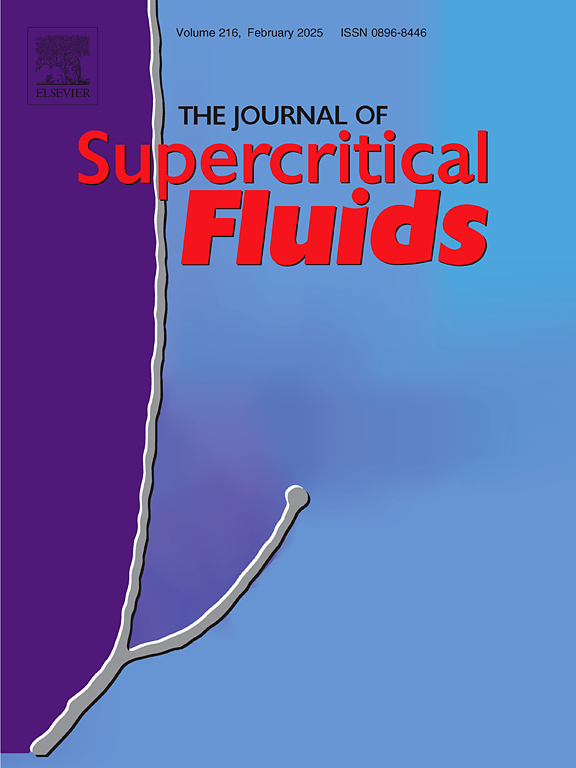Sustainable utilization of disposed photovoltaic backsheet to microcellular thermal-insulation foam through two-steps supercritical CO2 foaming
IF 4.4
3区 工程技术
Q2 CHEMISTRY, PHYSICAL
引用次数: 0
Abstract
Upcycling of disposed photovoltaic backsheets plays important role in sustainable development of the photovoltaic industrial chain. However, the melt strength of the main component (rPET) decreased dramatically after long-term outside exposure, it is still challenging to develop a rPET-based microcellular thermal-insulation foam. Herein, we utilize a crystalline-amorphous network (CAN) strategy to enhance rPET melt strength and develop microcellular thermal-insulation material via supercritical CO2 (scCO2) foaming technology. The tunable CAN fractions can be achieved by manipulation of crystallinity and rigid amorphous fraction (RAF) via annealing processes. The crystallinity was increased to 31.9 % for the sample annealed at the temperature of 115 °C, while the RAF value rose to 44.6 %. Consequently, the zero-shear complex viscosity () of rPET samples increased from 164.2 Pa·s to 1826.6 Pa·s with increased CAN fractions up to 76.5 %, demonstrating a typical shear-thinning behavior. Combined with the scCO2 foaming technology, the void fraction can be tuned from 31.6 % to 83.5 %. The cell density was optimized, reaching a high value of 1.12 × 109 cells/cm3 with the CAN fraction of 21.5 %. Furthermore, the thermal conductivity decreased from 254 mW•m−1K−1 for a solid rPET sample to 47.3 mW•m−1K−1 for thermal-insulation rPET foam. As a proof of concept, this work provides a novel route for resource utilization of disposed photovoltaic backsheet.
通过两步超临界CO2发泡,利用废弃光伏背板制备微孔隔热泡沫材料
废弃光伏背板的升级利用对光伏产业链的可持续发展具有重要意义。然而,由于主要成分(rPET)在长期暴露于外界后,其熔体强度急剧下降,因此开发基于rPET的微孔保温泡沫材料仍然具有挑战性。在此,我们利用晶体-非晶网络(CAN)策略来提高rPET熔体强度,并通过超临界CO2 (scCO2)发泡技术开发微孔隔热材料。可调的CAN分数可以通过退火工艺控制结晶度和刚性非晶分数(RAF)来实现。在115 ℃退火后,结晶度提高到31.9 %,RAF值提高到44.6% %。结果表明,rPET样品的零剪切复合粘度(η0*)从164.2 Pa·s增加到1826.6 Pa·s, CAN组分增加到76.5%,表现出典型的剪切减薄行为。结合scCO2发泡技术,可将孔隙率从31.6%调至83.5%。优化后的细胞密度达到1.12 × 109个细胞/cm3, CAN含量为21.5%。此外,导热系数从固体rPET样品的254 mW•m−1K−1下降到保温rPET泡沫的47.3 mW•m−1K−1。作为一种概念验证,本研究为废弃光伏背板的资源利用提供了一条新的途径。
本文章由计算机程序翻译,如有差异,请以英文原文为准。
求助全文
约1分钟内获得全文
求助全文
来源期刊

Journal of Supercritical Fluids
工程技术-工程:化工
CiteScore
7.60
自引率
10.30%
发文量
236
审稿时长
56 days
期刊介绍:
The Journal of Supercritical Fluids is an international journal devoted to the fundamental and applied aspects of supercritical fluids and processes. Its aim is to provide a focused platform for academic and industrial researchers to report their findings and to have ready access to the advances in this rapidly growing field. Its coverage is multidisciplinary and includes both basic and applied topics.
Thermodynamics and phase equilibria, reaction kinetics and rate processes, thermal and transport properties, and all topics related to processing such as separations (extraction, fractionation, purification, chromatography) nucleation and impregnation are within the scope. Accounts of specific engineering applications such as those encountered in food, fuel, natural products, minerals, pharmaceuticals and polymer industries are included. Topics related to high pressure equipment design, analytical techniques, sensors, and process control methodologies are also within the scope of the journal.
 求助内容:
求助内容: 应助结果提醒方式:
应助结果提醒方式:


